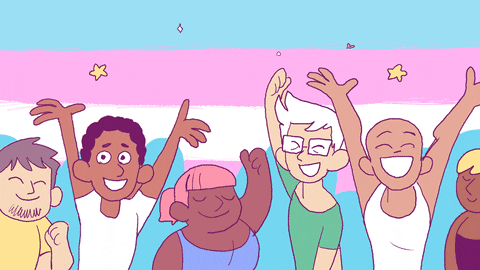Nonbinary in the Classroom
This post is written by Sam Hertl (they/them pronouns), a social work intern completing their field placement in the Women’s Center.
*Trigger warning*
There are heavy topics mentioned such as the rate of violence against trans lives, suicide, and mental health issues. Please read with caution.

The two hearts pictured show the trans flag to the left and the nonbinary flag to the right.
Can I just say that living in a society where the highest court must debate and make a decision as to whether or not LGBTQ+ people will be safe from workplace discrimination is incredibly taxing as a queer person? When protective factors (like employment) for marginalized communities are up for federal debate, holding one or multiple marginalized identities becomes increasingly difficult no matter if you are in the workplace or preparing to be. This means that finding a space where your identities are not only recognized but respected and affirmed is crucial to living a healthy life.
This may not be news to most, but the trans community faces tremendous minority stress and endures an alarming rate of violence. Trans students have been vocal about their struggles in educational settings, for example. They’ve reported being less involved in school due to lack of visibility, little to no connections with campus and local trans communities, burn out, mental health concerns, and structural barriers in their institution.
Even with all the drawbacks, there are a lot of reasons why trans folks would and do go to college. Some go to learn more about themselves and the world. Others go to help increase their chances of entering a better position in the workforce. Regardless of one’s motivations, trans people in the classroom are preparing for the workplace and already seeing moments of inequity.
At UMBC, students face similar issues. Recently UMBC’s student newspaper, The Retriever, posted an article noting the lack of protection for trans students who are misgendered during their time at UMBC. Journalist Johanna Alonso features trans students who detail their personal experiences being misgendered both in and outside of the classroom.

The following are specific issues myself and my nonbinary peers have experienced while in college:
Avoidance & Misgendering
- Being told by people, both peers and professors, that they need time to grapple with your pronouns and/or gender identity.
- People actively avoiding using your pronouns even when you’ve asked them to use your pronouns, and instead using only your name every time they address you.
- Professors completely avoiding addressing you. This can be for a variety of reasons such as avoiding using your pronouns altogether, avoiding messing up your pronouns, or because they personally disagree with your gender identity. This unknown can cause excess stress.
- Preemptively avoiding participation in class to avoid more people misgendering you when they address you.
- Professors deadnaming you during roll call due to numerous structural barriers that prevent you from having your name legally changed or alternated in school databases.
Tokenization
- People asking extremely personal questions with the expectation that you have to share with them.
- Sharing extremely personal experiences with people anyway to communicate how important it is for folks to use your pronouns (and they still don’t use your pronouns correctly).
- Peers misgendering you while in class with no space to correct them in the moment. Sensing those peers didn’t realize they misgendered you and then just sitting with that through the rest of class, feeling that it’s too late to bring it up.
- Being the only openly trans person in the classroom and feeling isolated in your feelings.
- Acting as an educator and spokesperson for the entire trans community when you are only one person.
Content Erasure
- Hearing and seeing “he/she” in assignments, powerpoints, and lectures when a singular “they” could easily fit into the sentence grammatically and be more inclusive.
- Having to dissociate throughout class because attendance is mandatory even when it’s not a safe environment for trans people and being unable to learn properly because of this.
- Learning classroom content that applies to, but never mentions the experience of people in the trans community.
- Never learning about the trans community’s specific needs in classes and knowing that your professors and peers will continue to perpetuate a trans exclusive world because your professor, department, or curriculum isn’t doing the work that it should.
Take a moment to let that all settle in. Reread it. This is important. This is not made up or abstracted. These are experiences that I myself and my peers have had.

If you’re reading through these pieces and thinking that some of these things are avoidable, you’re totally right! The following are some terms and concepts that’ll help you understand how.
Minority Stress Model
Stress that stems from systemic prejudice has a real and lasting negative impact. The National Institute of Health published an article by Ilan H. Meyer defining minority stress as, “The excess stress to which individuals from stigmatized social categories are exposed as a result of their social, often a minority, position.” There are some limitations to the focus (specifically on sexuality) in this article, but it can be extended to gender identity and other people who have marginalized identities. Meyer details the four main processes of minority stress in relation to the experiences of sexual minorities:
- External factors, objective stressful events, and conditions (both chronic and acute).
- Expectations of such external events and the vigilance this expectation requires.
- The internalization of negative societal attitudes.
- Concealment of one’s sexual orientation/identity.
The social environment often provides meaning to people. Situations in the social environment can lead to stressors such as listed above. Although stress is not linked only to holding a minority identity, it is certainly an important aspect to note. I will use the processes in this minority stress model to further explain the three categories featured above about the nonbinary classroom experience. Refer to the listed points above while reading about each category.
Avoidance & Misgendering
As an aspiring social worker, this is disappointing to see in my classes. Nonbinary students in other majors, such as STEM-related fields, may not get the opportunity to study other people’s identities and thereby have even less space to learn about differing identities.
When considering the minority stress model, it is clear that external factors in educational settings such as the lack of knowledge and awareness about nonbinary identities can create stressful moments for nonbinary students. It doesn’t help when nonbinary students are exposed to harmful educational environments where professors and peers repeatedly misgender the student. Therefore, nonbinary students often anticipate these scenarios ahead of time. Worrying about when the next time someone will misgender them can cause excess anxiety and discomfort for nonbinary folks when in these harmful environments.
Students who have “non-western” names, whether cis or trans, often face similar avoidance in their classes. Professors mispronounce names, mix up the names for students of color in the class, or actively avoid addressing students with names they frame as difficult to pronounce. This communicates to these students that their name isn’t worth learning. Rita (‘ree-the’) Kohli, an assistant professor at the University of California, Riverside noted, “Is it framed as my inability to say someone’s name or is it framed as the student doing something to make your life more difficult?”.
Tokenization
Being an openly trans student in the classroom sometimes means that you are the only publicly known trans person in the room (and for many, the only trans person they are aware of in their lives). This often somehow translates to cis professors and peers that you are the spokesperson for the entire trans community, and that’s only if they acknowledge your trans identity. For this reason, many professors and peers expect you, the local trans person, to provide the class with real-life examples so they can better understand you, or trans people as a whole. It’s burdening to be seen as a representative of a community that you only partly embody.
It’s endearing that some cis people want to learn, but it shouldn’t be the burden of the only trans person in the room to teach everyone about trans identities and trans lives. As a social work major, this is increasingly harmful to experience in my classes, but again it’s essential to note that trans students in courses outside of the humanities and social sciences often don’t even get the opportunity to learn about different populations of people.
Many departments in college settings do not have a gender-inclusive and trans-affirming curricula. It’s typically only Gender, Women’s, and Sexuality Studies courses (whose express mission it is to expand our lens on gender) that mention trans people at all, let alone those with nonbinary identities specifically. In relation to the minority stress model, being isolated as the only openly trans person in the room can create even more stressful events for trans individuals and inherently cause trans folk to internalize the act of othering created by trans unaware peers and professors.
Erasure
Although all people experience otherness, there is often also an erasure of identity. With gender identity, it’s a constant battle in the classroom. Many professors may not realize the power and influence they have. Some students end up keeping their gender identity hidden if they face other stressors. Many LGBTQ+ students with disabilities tend to disclose only one of their potentially invisible identities when in a group setting. They may not be given space to disclose any of their identities in the first place.
This lack of space may create an unsafe environment and make it harder for those who hold multiple invisibility identities on top of disability status to disclose other aspects of their identity such as gender identity and sexuality. This leads to an overwhelming amount of erasure faced by students with these intersecting identities which can result in both shame and isolation for these folks. Looking at the minority stress model, this can be noted as the concealment of one’s identity.

Impact on Students
There is a strong need for affirmation in the classroom that is not happening. For example, language professors use in their lectures and assignments has a harmful impact. Binary language can be the usage of “he or she”, “mom or dad”, and “sister or brother” when “they”, “parent”, and “sibling” are easy and gender-inclusive alternatives for these terms. It’s increasingly difficult to learn as a nonbinary person in an educational setting that doesn’t make space for nonbinary people. The repeated exposure of seeing binary language can make nonbinary people feel invisible.
It’s also all too common for professors to teach content that applies to trans folks without mentioning them. In a social work class I took, for example, the professor dedicated a class discussion to adolescent suicide; however, there was not one mention of trans adolescents who face suicidal ideation. For the record, trans adolescents face suicidal ideation at a much higher rate than their cis classmates. When I raised this concern in class, as we are often encouraged to share our own knowledge and perspectives in the classroom, the professor seemed tense and tried to move on quickly. A nonbinary peer took this same class the following semester with the same professor and had a similar experience during the class dedicated to adolescent suicide. Avoiding these topics will cause a ripple effect in the rising class of professionals and continue to harm those who have marginalized identities that aren’t talked about in class.
The alarming rates of violence against black trans women are a testament to this truth. Each year the Human Rights Campaign (HRC) tracks the disparately high rates of violence against the trans community, mostly impacting black trans women. This year the HRC has reported that, “2019 has already seen at least 22 transgender or gender non-conforming people fatally shot or killed by other violent means”. It is indisputable that people within the trans community are faced with tremendous challenges that can put their lives at risk. For this reason, trans folks (especially trans people of color) need extra support and resources to maintain a safe and prosperous livelihood.
The probability of hardship and discrimination faced by the trans community can lead to poor mental health. The Report of the 2015 U.S. Transgender Survey documents the overall health and wellness of the trans community and states that, “Thirty-nine percent (39%) of respondents were currently experiencing serious psychological distress, nearly eight times the rate in the U.S. population (5%).”
The following is a quote by feminist Adrienne Rich which adequately sums up the immense impact professors can have on students.
“When someone with the authority of a teacher describes the world and you are not in it, there is a moment of psychic disequilibrium, as if you looked into a mirror and saw nothing”
Everyone has felt invisible before. Think of a time you felt this way. Consider this in relation to everything aforementioned.
Administrators, please monitor your educational environments and aim for inclusive excellence. Professors, please put in the work to revamp your classroom content. Peers, be an advocate for your nonbinary classmates. Parents of nonbinary and trans folks, pay attention to how school impacts your child. Everyone, ask the nonbinary and trans people in your life how you can best be there for them.
I don’t have all the answers, nobody does. I just ask that you take this seriously and start to do better. The following are a few tips I have for you after reading this blog:
- Learn how to look at gender differently. Challenge yourself, ask genuine questions, and do the research.
- Ask your nonbinary and trans friends for their preferences (and consent) when it comes to how publicly they use their pronouns and how they want you to correct yourself if you misgender them.
- When introducing yourself to someone new, make it habit of telling them your name and pronouns. Follow up and ask for their name and pronouns. This might not be something that you accustomed to doing, but we are in the process of unlearning, and you can’t assume someone’s name before meeting them, so how could you assume their pronouns?
- Learn how to give a quick and easy presentation on pronouns to give to people who aren’t familiar with the importance of pronouns.
- When someone corrects you after you’ve misgendered them, tell them thank you for correcting you and restate the sentence with the correct pronouns.
If this work is prioritized in the classroom, imagine how inclusive the next generation will be?

Additionally, I want to thank the professors and peers who have been putting in the work to affirm and normalize nonbinary and trans identities. Keep up the amazing work and encourage your cis friends to do the same.
Here are some epic resources for folks to learn more:
Resources for cis folk:
Videos
- Short video explaining they/them pronouns
- Trans folks describing what a trans identity is in their own words
- Ted talk on how to talk and listening to trans folks
- UMD LGBT Equity Center on sharing pronouns
Websites
Resources for trans & nonbinary folk:
- Planned Parenthood advice on coming out as trans
- Recommendations for clothing shopping as a GNC person
- The Trevor Project Support Center
- The UMBC Counseling Center group page including a trans support group

*Disclaimers*
Hi, I use they/them/their pronouns and my gender identity is nonbinary. I recognize that this is only one perspective. I am not able to represent all nonbinary identities.
I use the term trans when discussing the whole trans community and I use the term nonbinary when talking about nonbinary people specifically within the trans community. I will also be using nonbinary as an umbrella term that is extended to, but not limited to genderqueer, genderfluid, and gender non-conforming identities. Some nonbinary people do not identify as trans, although the language I use in this blog post suggests that all nonbinary folk do.
Posted: November 5, 2019, 12:09 PM
